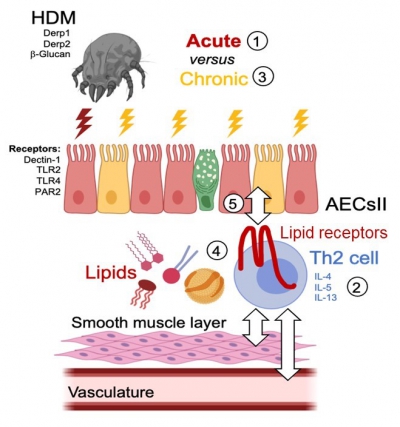P12-2: Th2 cell-dependent effects on the airway epithelial barrier during chronic asthma
Anna KronePhD Student
Sascha KahlfussProject Leader |
Allergic asthma is characterized by chronic inflammation and airway remodeling, which involves epithelial barrier dysfunction, fibrosis, goblet cell hyperplasia/metaplasia, smooth muscle thickening and increased endothelial permeability. Repetitive chronic exposure to allergens such as from house dust mites (HDM) mediates a dysregulation of the airway epithelia including alveolar type II cells (AECsII). This cumulates in Th2 cell activation and the amplification of asthmatic airway inflammation. However, how the intercellular communication between alveolar epithelial cells and Th2 cells contributes to the fixation of especially chronic asthmatic airway inflammation is not fully understood yet. We hypothesize that in chronic asthma, metabolites provide a specific metabolic environment within the lung, which favors chronic inflammation and fixation of the disease by changing the epithelial barrier. To address this question project 12 will use mice with a conditional deletion of a subclass of lipid receptors in T cells and analyze their potential to develop asthmatic airway inflammation using an acute and a subacute (chronic) HDM lung inflammation model. From these mice, we will isolate T cells and AECsII (cooperation with project 2), analyze their transcriptome by bulk and single cell RNA sequencing (scRNAseq) and study gene regulation by single cell Assay for Transposase-Accessible Chromatin with high-throughput sequencing (scATACseq). Further, we will investigate whether the T cell-specific deletion of certain lipid receptors alters the epithelial barrier integrity during chronic asthmatic airway inflammation (cooperation with Project 4 and Project 8). The ultimate goal of project 12 will be to understand the detailed molecular mechanisms, epigenetic regulation and signaling networks in AECsII (in cooperation with Projekt 1) that are affected by lipid signaling in T cells during the fixation of chronic asthma. |
Photos: by UMMD, Melitta Schubert/Sarah Kossmann






 Th2 cell-dependent effects on the airway epithelial barrier during chronic asthma. 1) Components of HDM (Derp1, Derp2, LPS, ß-glucan) acutely activate receptors (Dectin-1, TLR2, TLR4, PAR2) on AECsII. Proteases of HDM destroy gap junctions and antigenic HDM determinants are phagocytosed by DCs and presented in mediastinal lymph nodes to naïve T cells. HDM-primed T cells differentiate into Th2 cells and migrate to the lung. 2) Here, Th2 cells secrete IL-4, IL-5, and IL-13, which mobilize eosinophils to the airways and mediate the production of HDM-specific IgE. 3) Chronic asthmatic airway inflammation through repetitive stimulation with HDM extract. 4) Metabolites such as lipids activate lipid receptors on lung Th2 cells. 5) Lipid receptors on Th2 cells are important for their pathogenic potential in mediating asthma and for the interaction between Th2 cells and the alveolar epithelia during the establishment of chronic inflammation (hypothesis). Abbreviations: HDM, house dust mites; DC, Dendritic cell; Th2 cell, T helper 2 cell; AECII, Alveolar type II cell.
Th2 cell-dependent effects on the airway epithelial barrier during chronic asthma. 1) Components of HDM (Derp1, Derp2, LPS, ß-glucan) acutely activate receptors (Dectin-1, TLR2, TLR4, PAR2) on AECsII. Proteases of HDM destroy gap junctions and antigenic HDM determinants are phagocytosed by DCs and presented in mediastinal lymph nodes to naïve T cells. HDM-primed T cells differentiate into Th2 cells and migrate to the lung. 2) Here, Th2 cells secrete IL-4, IL-5, and IL-13, which mobilize eosinophils to the airways and mediate the production of HDM-specific IgE. 3) Chronic asthmatic airway inflammation through repetitive stimulation with HDM extract. 4) Metabolites such as lipids activate lipid receptors on lung Th2 cells. 5) Lipid receptors on Th2 cells are important for their pathogenic potential in mediating asthma and for the interaction between Th2 cells and the alveolar epithelia during the establishment of chronic inflammation (hypothesis). Abbreviations: HDM, house dust mites; DC, Dendritic cell; Th2 cell, T helper 2 cell; AECII, Alveolar type II cell.